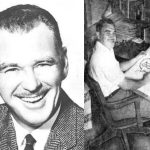King Aroo, a delightful and eccentric comic strip created by Jack Kent, emerged onto the scene on November 13, 1950, enchanting readers with its whimsical tales until June 19, 1965. Distributed by the McClure Syndicate, the strip introduced us to Myopia’s charming and surreal realm, ruled by the equally whimsical King Aroo. This article delves into the characters, the creative genius of Jack Kent, and the journey of King Aroo by Golden Gate Features from its inception to its limited syndication.

Characters and Story:
King Aroo – The Monarch of Myopia:
The heart of the strip lies in its central character, King Aroo, the monarch of the mythical Myopia. Like iconic comic strips such as Krazy Kat, Pogo, and Barnaby, King Aroo carved its niche among devoted readers who appreciated its blend of sophistication and humor. Jack Kent, born 1920 in Burlington, Iowa, brought Myopia to life with a loose-lined art style teeming with characters and activity.
A Myopic Cast of Characters:
Supporting characters added depth to the Myopian universe. Yupyop, Lord High Almost Everything, Professor Yorgle, the scientific expert, Mr. Pennipost, the kangaroo mailman with an incredible pocket capacity, the forgetful Mr. Elephant, nosy court poet Dipody Distich, and Wanda Witch, the bird with a cart of “Spells and Curses, 5¢,” enriched the tapestry of King Aroo’s world.
Sophisticated Puns and Wordplay:
Comparable to Walt Kelly’s Pogo, Jack Kent infused King Aroo with sophisticated puns and wordplay, creating a comic strip that resonated with readers who cherished Krazy Kat, Barnaby, and Little Nemo. While the strip didn’t attain the same level of prominence as Blondie or Hi & Lois, it undeniably secured its place in the hearts of its dedicated audience.

Jack Kent’s Legacy:
From Hambone’s Meditations to King Aroo:
Jack Kent’s journey in comics began with Hambone’s Meditations, a panel created by his father, J.P. Alley. Taking over the nationally syndicated comic after his father’s passing in 1934, Kent’s artistic talent and lack of formal art training gave birth to a unique style that characterized King Aroo.
Home Sweet Castle:
The love for King Aroo transcended the comic strips into Jack Kent’s personal life. Jack and June Kent named their home on the banks of the San Antonio River “King Aroo’s Castle,” a testament to the impact of the whimsical kingdom on the creator’s life.

Collections and Reprints:
The Early Collections:
In 1953, Doubleday published a 192-page book, King Aroo, collecting the early strips. Gilbert Seldes contributed an introduction to this collection, offering readers a deeper understanding of the enchanting world of Myopia.
IDW’s Complete Reprint:
In April 2010, IDW Publishing and The Library of American Comics embarked on a journey to provide readers with a comprehensive reprint of King Aroo. The first volume covered dailies and Sundays from 1950 through 1952, edited and designed by Dean Mullaney. Despite difficulties locating specific strips, subsequent volumes brought the world of Myopia back to life, allowing readers to relive the magic of King Aroo.

The Rise and Fall:
A Runaway Hit or a Cult Classic?
Unlike comics with widespread popularity, such as Nancy or The Family Circus, King Aroo found its place among the intelligentsia. Adored by a niche audience, it never achieved the status of a mainstream hit but captured the hearts of those who appreciated its intellectual charm.
The McClure Syndicate and Golden Gate Features:
Launched by the McClure Syndicate in 1950, King Aroo faced challenges when the syndicate merged with The Bell Syndicate in 1952. Stanleigh Arnold of the San Francisco Chronicle was rescued, establishing Golden Gate Features to continue syndicating King Aroo. However, despite noble efforts, the strip folded in 1965.
Jack Kent’s Post-King Aroo Journey:
Following the conclusion of King Aroo, Jack Kent ventured into freelance cartooning for magazines and greeting card companies. His illustrious career took a turn toward children’s literature, earning him recognition as an award-winning children’s author. Unfortunately, Jack Kent passed away in 1985, never returning to the enchanting world of King Aroo except for a few characters making a cameo in his 1969 book, Mr. Elephant’s Birthday Party.

The Resurgence and Beyond:
From Obscurity to IDW’s Reprint:
King Aroo remained in occasional reprints scattered across obscure journals for many years. The year 2009 marked the end of its obscurity as IDW Publishing initiated the complete reprint project, bringing the surreal kingdom of Myopia back into the spotlight.
Legacy Beyond Strips:
King Aroo’s legacy extends beyond the comic strips, finding a new life in the pages of IDW’s reprints. The resurgence has introduced a new generation to the charm of King Aroo, celebrating its place among the greats like Krazy Kat and Pogo.

Conclusion:
In the vast landscape of comic strips, King Aroo stands as a testament to the notion and creativity of Jack Kent. From its debut in 1950 to its limited syndication by Golden Gate Features, the strip left an indelible mark on the hearts of readers who appreciated its intellectual charm. With IDW’s reprints, King Aroo continues to enchant audiences, inviting them to explore the surreal kingdom of Myopia and witness the enduring legacy of a truly unique comic strip.
Read also
- Jack Kent: The Creative Journey of a Prolific Cartoonist and Author-Illustrator
- The Endearing Charm of Winnie the Pooh and Friends
FAQs about King Aroo
1. What is King Aroo?
King Aroo is an American comic strip created by Jack Kent. It debuted on November 13, 1950, and remained until June 19, 1965. The strip was distributed through the McClure Syndicate.
2. Who is the central character of King Aroo?
The central character is King Aroo, the monarch of the mythical Myopia. Supporting characters include Yupyop, Professor Yorgle, Mr. Pennipost, Mr. Elephant, Dipody Distich, and Wanda Witch.
3. How does King Aroo compare to other comic strips?
King Aroo is often compared to Walt Kelly’s Pogo. Jack Kent’s strip is known for sophisticated puns and wordplay, appealing to Krazy Kat, Barnaby, Pogo, and Little Nemo fans.
4. What is the significance of King Aroo in comic history?
King Aroo is celebrated among comics enthusiasts and is appreciated by readers who enjoy intellectual and creatively rich comic strips.
5. Is there a collection or reprint of King Aroo available?
Yes, the early strips were collected in a 192-page book titled “King Aroo,” published by Doubleday in 1953. In April 2010, IDW Publishing and The Library of American Comics released the first volume of a complete reprint, covering dailies and Sundays from 1950 through 1952.
6. Why did King Aroo come to an end?
The syndicate faced challenges, and King Aroo changed hands several times. It folded in 1965, and Jack Kent pursued a career as a children’s author. The strip was revived in occasional reprints, with a complete reprint published by IDW in 2009.
7. Where can I find King Aroo today?
King Aroo is available in reprints, including the complete reprint published by IDW in 2009. Fans and collectors may also find occasional reprints in journals or publications dedicated to classic comics.
8. What is Jack Kent’s legacy beyond King Aroo?
Jack Kent continued his career as an award-winning children’s author after the end of King Aroo. His contributions to children’s literature are notable, and he passed away in 1985.
9. Are there any notable characters or elements in King Aroo?
Besides King Aroo, characters like Yupyop, Mr. Pennipost, and Professor Yorgle are frequently seen in the strip. The imaginative and surreal nature of the strip sets it apart.
10. How long did King Aroo run, and what is its place in comic history?
King Aroo ran from 1950 to 1965. While not a runaway hit, it held readers’ interest and is celebrated for its unique style and creative approach, making it a noteworthy part of comic history.
This post was created with our nice and easy submission form. Create your post!





5 Comments